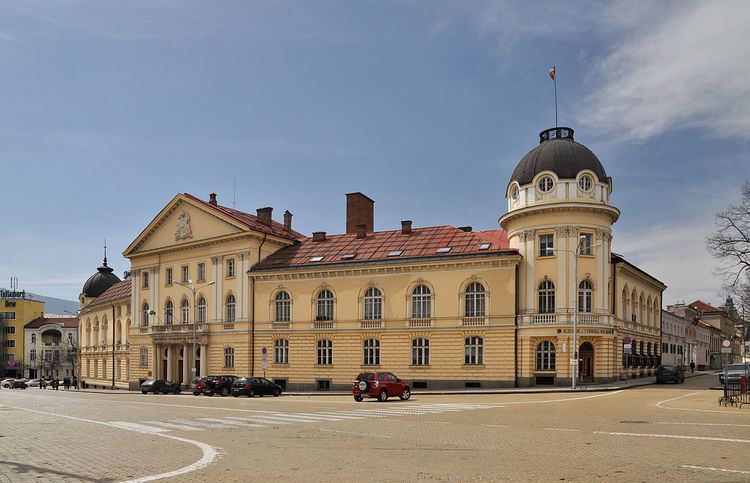The Bulgarian Academy of Sciences (abbreviated BAS, in Bulgarian: Българска академия на науките, Balgarska akademiya na naukite, abbreviated БАН) is the National Academy of Bulgaria, established in 1869. The Academy, located in Sofia, is autonomous and has a Society of Academicians, Correspondent Members and Foreign Members. It publishes and circulates different scientific works, encyclopedias, dictionaries and journals, and runs its own publishing house.
Stefan Vodenicharov has been president of the BAS since 2012. Its budget in 2009 was 84 million leva, or 42.7 million euro. The Bulgarian Space Agency, part of the BAS, has a budget of 1 million euro.
As Bulgaria was part of the Ottoman Empire, Bulgarian émigrés founded the Bulgarian Literary Society on 26 September 1869, in Brăila in the Kingdom of Romania. The first Statutes accepted were:
Board of Trustees
Nikolai Tsenov – PresidentVasilaki MihailidiPetraki SimovKostaki PopovichStefan BeronActing members:
Marin Drinov (1838-1906) – ChairmanVasil Drumev (1840-1901) – MemberVasil D. Stoyanov (1839-1910) – SecretaryThe following year, the Literary Society began issuing the Periodical Journal, its official publication, and in 1871 elected its first honorary member - Gavril Krastevich.
In 1878, shortly after Bulgaria's liberation from Ottoman rule, the General Assembly voted to move the seat of the Society from Brăila to Sofia, and on 1 March 1893 the BLS moved into its own building, right next to where the Bulgarian Parliament is seated. The BLS headquarters were completed in 1892. The building was designed by architect Hermann Mayer and was expanded during the 1920s.
The Bulgarian Literary Society adopted its present-day name in 1911, and Ivan Geshov became the Academy's first president. The BAS became a member of the Union of Slavonic Academies and Scientific Communities in 1913, and was accepted as member of the International Council of Scientific Unions in 1931.
The BAS has 9 main sections, more broadly united under three main branches: Natural, mathematical and engineering sciences, Biological, medical and agrarian sciences and Social sciences, humanities and art. Each consists of independent scientific institutes, laboratories and other sections.
Institute of Mathematics and InformaticsInstitute of MechanicsInstitute of Information and Communication TechnologiesNational Laboratory of Computer VirologyInstitute for Nuclear Research and Nuclear EnergyInstitute of Solid State PhysicsInstitute of ElectronicsInstitute of AstronomyNational Astronomical Observatory - RozhenAstronomical Observatory BelogradchikCentral Laboratory of Solar Energy and New Energy SourcesCentral Laboratory for Applied Physics - PlovdivCentral Laboratory of Optical Storage and Processing of InformationInstitute of General and Inorganic ChemistryInstitute of Organic Chemistry with a Center of Phyto-ChemistryInstitute of Physical ChemistryInstitute of CatalysisInstitute of Electrochemistry and Energy Systems (IIES) (former Central Laboratory of Electrochemical Power Sources)Institute of Chemical EngineeringCentral Laboratory of PhotoprocessesInstitute of PolymersInstitute of NeurobiologyInstitute of Molecular BiologyInstitute of GeneticsInstitute of PhysiologyInstitute of Plant PhysiologyInstitute of MicrobiologyInstitute of Experimental Morphology and AnthropologyInstitute of BotanyInstitute of ZoologyForest Research InstituteInstitute of Experimental Pathology and ParasitologyInstitute of Biology and Immunology of ReproductionInstitute of BiophysicsNational Museum of Natural HistoryCentral Laboratory of Biomedical EngineeringCentral Laboratory of General EcologyGeological InstituteGeophysical InstituteNational Institute of Meteorology and HydrologyCentral Laboratory for GeodesyCentral Laboratory of Mineralogy and CrystallographyInstitute of OceanologyGeographical InstituteSpace Research InstituteCentral Laboratory of Solar - Terrestrial InfluencesCentral Laboratory for Seismic Mechanics and Earthquake EngineeringInstitute of Water ProblemsInstitute of Metal ScienceCentral Laboratory of Physico-Chemical MechanicsInstitute of Computer and Communication SystemsInstitute of Information TechnologiesInstitute of Control and System ResearchCentral Laboratory of Mechatronics and InstrumentationBulgarian Ship Hydrodynamics CentreHumanities (Division 'Cultural-Historical Heritage and National Identity')
Institute of Bulgarian LanguageInstitute of LiteratureInstitute for Balkan Studies and Center for ThracologyInstitute for History StudiesInstitute for Ethnology and Folklore Studies with Ethnographic Museum, comprising the formerInstitute for Folklore StudiesEthnographic Institute with MuseumInstitute for Arts Studies, comprising the formerCenter for Architectural StudiesInstitute of Art StudiesNational Archaeological Institute and MuseumScientific Center for Cyrillo-Methodian StudiesSocial Sciences (Division 'Man and Society')
Institute for Economic StudiesInstitute for the State and LawInstitute for Population and Human Studies, comprising the formerInstitute of PsychologyCenter for Population StudiesInstitute for the Study of Societies and Knowledge, comprising the formerInstitute of SociologyInstitute of Philosophical StudiesCenter for Science Studies and History of ScienceSpecialized and Supporting Units
Central Administration of BASCentral Library of BASScientific Archives of BASAcademic Publishing House "Prof. Marin Drinov"Botanical GardenNational Centre on Nanosciences and NanotechnologyBulgarian Encyclopedia Scientific Information CenterSocial - Utility ServiceCenter for National Security ResearchResearch Development and Implementation Association "Scientific Instrumentation"Laboratory of TelematicsPh.D. Research Career Development CenterAcademia Peak and Camp Academia on Livingston Island in the South Shetland Islands, Antarctica are named for the Bulgarian Academy of Sciences in appreciation of Academy’s contribution to the Antarctic exploration.

